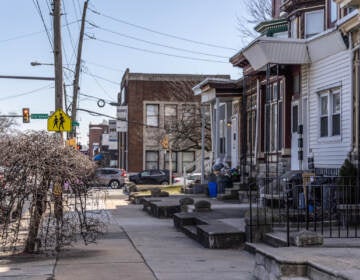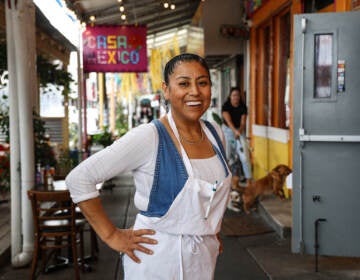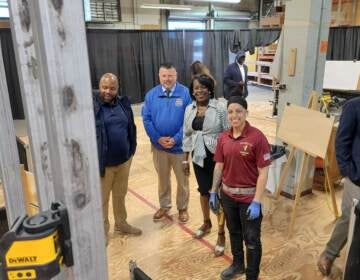Having hard conversations with children about race and difference
Current research indicates that children as young as 2 years old show awareness of racial differences and may express racial prejudice by age 4.

Jasmine Miller, chair of Cooperative Nursery School's diversity committee. (Paul Jablow/The Notebook)
This article originally appeared on The Notebook.
—
Lindsay Edwards was delighted when her 4-year-old son, Grey, came home from school wanting to talk about the Rev. Dr. Martin Luther King Jr.
“He was killed because people didn’t agree with what he was saying,” said Grey, who attends the Cooperative Nursery School (CNS) in West Mount Airy.
“And people disagreed with him because he had black skin. People should have just said, ‘I’m sorry, but I don’t agree with you,’ rather than shooting him. He was shot because he had that color skin.”
Grey still asks his mom to visit King’s gravesite so he can say, “Hi, and I’m sorry.”
For Edwards, who is white, the conversation was proof that the school’s diversity efforts, highly unusual in a preschool, were having an impact. (Read the first part of the story about diversity efforts by CNS here.)
She found it a breath of fresh air because when she was growing up in Chattanooga, Tennessee, “Racism wasn’t discussed in our family.” And in school, ”I was never taught proper history.”
Current research indicates that children as young as 2 years old show awareness of racial differences and may express racial prejudice by age 4.
By kindergarten, they may mirror racial attitudes they see at home or elsewhere in the adult world.
There is also some research indicating that although black or Latino children show no preference for particular groups by age 5, white children tend to be biased toward their own group.
And between the ages of 3 and 5, said Linda Hawkins, co-director of the Gender & Sexuality Development Clinic at Children’s Hospital of Philadelphia (CHOP), they “begin to have an innate sense of their gender identity.”
“Around this time, they also start to pick up on the subtle and not-so-subtle gender expectations in their family, their day care, their church, and their community,” she said.
The 2017 National School Climate Survey conducted by GLSEN, a national organization advocating for LGBTQ students, found that only 13 percent of students attended a school that had a comprehensive anti-bullying/harassment policy that covered LGBTQ issues.

The goal of CNS is nothing less than changing the way the children talk about race and gender, both among themselves and with their parents.
The philosophy is that not discussing race just leaves a vacuum for children to draw their own conclusions, for better or for worse.
“It’s about having those tough, awkward conversations,” said CNS parent Jasmine Miller, the school’s diversity committee chair.
“We try to create different opportunities and spaces to have conversations about diversity. And because cooping parents and caregivers are present on a daily basis, the workshops help all the adults have a common language when interacting or addressing issues with the children.”
School director Leah Corsover points out that for teachers and parents, “When a kid says, ‘I don’t like people with brown skin,’ you have to deal with it right at that moment.”
Deidre Ashton, a licensed clinical social worker who has led parent workshops about race at the school, said that this is a skill parents have to work on.
What to do when a child expresses insensitivity
If a child makes an insensitive remark, she said, “We need to do more than say, ‘That’s not nice.’ We need to help them make a better choice.
“But then our own stuff comes up and we get paralyzed.”
Although much of the current dialogue about racism involves power relationships, this may be a difficult concept for young children to grasp.
But Ashton said it’s more easily approached through the lens of justice.
“When kids are young, they’re concerned about what’s fair,” she said. “They might not talk about power.
“They do notice that villains in books tend to be darker, heroes might be white. There are subtle ways in which the world devalues darkness.”
Beyond celebrating diversity
“To end racism,” she said, “we have to educate children to see race,” beyond just celebrating diversity.
“It’s beyond personal bias. It’s a system. It’s helping them name what they see and giving meaning to that,” talking in terms of groups rather than just individuals.
By starting earlier with discussions of race, she said, as the children get older, “that conversation becomes richer and more complex.”
For white people, in school settings or elsewhere, she said, the issue goes beyond recognizing bias. They must also recognize, accept and deal with the privilege that their skin color gives them.
So when talking to children about the absence of people of color in literature, she said, it’s important to discuss “what that absence means.”
“Biracial and multiracial families,” she added, “also face challenges as they work to embrace all aspects of their identity, both privilege and marginalization.”
She said that when she works with children of middle or high school age who have skills and competency in talking about race and racism, they tend to talk about adults who discussed race with them at an earlier age.
At CNS, she said, she talked to parents and teachers about what messages about race they received early in life and how those messages affected them.
Ashton describes an exercise using an incident that actually happened in the classroom with a white student and a white teacher, in which the white student assumed that a Latino man caring for a private garden was hired rather than the homeowner.
“When a child says something that’s racially harmful, you don’t want to devalue that child,” Ashton said. “You want to engage in a learning opportunity.” That involves unpacking what happened and talking about empathy.
In the workshop where this incident was used as an example, she said, “We role-played talking to the child, focusing on holding the child in positive regard, exploring the child’s thinking and presenting an alternative meaning.

“Kids are ready for these conversations if you approach them at the proper level.”
Samantha King, education coordinator at the CHOP clinic, recently held a workshop for the diversity committee at CNS on how to create a school atmosphere that is gender-inclusive.
“I go to spaces where people haven’t even heard the word transgender,” King said.
The stakes are higher in this area than most people realize.
King cites statistics indicating that 40 percent of transgender adults have attempted suicide in their lives, 10 times the rate of the general population. And transgender children as young as 5 or 6 have been known to express suicidal thoughts.
School support is a major plus, she said. “It’s a huge buffer against depression.”
Teaching about gender is, of course, more difficult, King said, because the gender a person identifies with is not always visible on the surface.
And the school tries to increase tolerance of different types of family groupings. An article in a recent newsletter was titled, “Don’t assume it’s Mommy or Daddy.”
“It’s fun watching how kids learn to use the language” about gender, King said.
Edwards, Grey’s mom, calls the school’s teaching of diversity “a vital, but unfortunately, unique experience.”
And she is aware that when Grey goes off to kindergarten, there may not be the same sensitivity about issues of race and gender as he found at CNS.
But she hopes that she can be a force to spread its philosophy of inclusion.
“We as parents,” she said, “are going to have to keep advocating.”
 The Notebook is one of 22 news organizations producing Broke in Philly, a collaborative reporting project on solutions to poverty and the city’s push toward economic justice. Read more at https://brokeinphilly.org and follow us on twitter @BrokeInPhilly.
The Notebook is one of 22 news organizations producing Broke in Philly, a collaborative reporting project on solutions to poverty and the city’s push toward economic justice. Read more at https://brokeinphilly.org and follow us on twitter @BrokeInPhilly.
WHYY is your source for fact-based, in-depth journalism and information. As a nonprofit organization, we rely on financial support from readers like you. Please give today.




